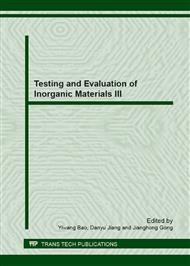p.8
p.13
p.17
p.21
p.25
p.29
p.34
p.38
p.43
Preparation of the Ceramic Hollow Balls of Aluminium Titanate-Based by Rolling-Ball Method
Abstract:
Aluminium titanate - based hollow balls were prepared by using aluminum titanate, mullite and magnesia aluminate spinel as starting materials followed by the rolling-ball method. The effect of different pore-making agents (namely the amylum, flour, millet and urea) on the forming properties and the apparent qualities of the precursors of the hollow balls were investigated. The results show that the precursors of the hollow balls own both good forming properties and apparent qualities when using the amylum as pore-making agent; an appropriate heat treatment was carried out on the above precursors, and the obtained hollow balls have particle size of 5 mm, aperture diameter of 3 mm and wall thickness of 1 mm; the average compressive strength of the hollow balls reaches 15.0 N. Since this method is very simple and effective for preparation of the hollow balls, it may provide a new approach for preparation of high performance heat insulation-porous materials.
Info:
Periodical:
Pages:
25-28
Citation:
Online since:
March 2013
Authors:
Keywords:
Price:
Сopyright:
© 2013 Trans Tech Publications Ltd. All Rights Reserved
Share:
Citation:


